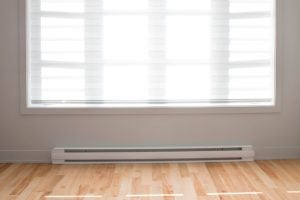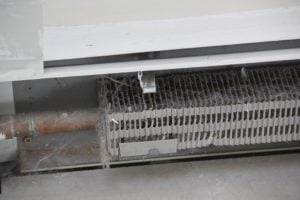Electric Baseboard Heaters – Tips, Risks, and How to Save
Looking to save on home upgrades? You can also save on home insurance by comparing quotes with us.
Home heating is an essential part of living in Canada. Our sub-zero winters require us to bundle up in cozy sweaters, don our fuzziest slippers, keep a fire going (if we’re lucky enough to have a fireplace), and crank up the heat.
If you live in an older apartment, you might have electric baseboard heaters. Or, if your current home isn’t as toasty as you’d like it to be, you might want to consider installing baseboard heaters for those cold spots – they’re still safer than a portable heater.
But, there are positives and negatives to baseboard heating; so here are some essentials to know about electric baseboard heaters before you move into a home or apartment that has them – or install one on your own.
What are electric baseboard heaters?
Electric baseboard heaters are heating systems that are installed along the floor of homes, typically under windows. They’re usually constructed of aluminium and house a metal heating element within.
They’re small but mighty heating systems – electric baseboard heaters heat individual rooms and can be run independently. That means you can turn on the baseboard heaters in the rooms you plan on using and save on heating costs by lowering the settings —or turning them off entirely—in your empty rooms.
The reason they’re usually found under windows is because the heat they produce will combat the cold air that enters through them. The same theory applies to those old school radiant heaters and even furnace vents.

Electronic vs. hydronic baseboard heater
Electronic baseboard heaters shouldn’t be confused with hydronic baseboard heaters.
Hydronic baseboard heaters are installed in similar locations as their electronic counterparts but, instead of relying on electrical currents to produce heat, they use heated fluid.
Electronic heaters take less time to heat up but usually cost more to operate than hydronic heaters, which also offer the benefit of longer heat retention.
Need home insurance?
In less than 5 minutes, you can compare multiple home insurance quotes from Canada's top providers for free.
Installing baseboard heaters
Before you install a baseboard heater, you need to know what size you’ll need for the room it’ll heat. You should calculate 10 watts per square foot of room area, according to The Spruce, a home DIY website.
An electric baseboard heater requires a 20-amp circuit, according to instructions on The Spruce. You’ll also have to install a cable from the electrical service panel in your home to the baseboard heater.
If you plan to have the heater connected to a separate thermostat, you’ll need to run a circuit cable from the thermostat to the heater. Again, this should be done by a professional.
Typically each baseboard heater has its own thermostat built in. You set each one to the heat you desire for that room. If you have a baseboard heater in the hallway of your apartment, you can set it to a lower level to save on the high cost of electricity.
How to maintain and clean electric baseboard heaters
Dust is the number one culprit you’ll want to watch out for. Make sure you regularly dust the outside casing of your baseboard heaters to keep them free of dust and debris with a vacuum. While dust generally doesn’t pose any danger, it can cause an unpleasant burning odour and reduce their energy efficiency. If left on too long, there’s an outside chance, it could spark a fire.
To clean, you can use a mild household cleaner or a duster to do the trick, depending on how much dust you’re dealing with and how long it’s been since your last clean.
Check the inside of the units regularly for any foreign objects as well. The front panel of your unit likely pops off, giving you access to the inside.
Before cleaning or checking your baseboard heater, make sure it’s turned off and unplugged. You want to make sure no electricity is running through it while poking around. Make it part of your summer or fall maintenance checklist.
You might also want to paint your baseboard heaters every so often. Because of the heat created by the heater, some paints may crack or bubble with time. When you do paint your baseboard heaters, make sure to use heat-resistant paint.

Cost to install a baseboard heating system
There are a few expenses involved in installing electric baseboard heating systems. You’ll have to pay for the heater, installation labour, and installation supplies. According to American home repair website Homewyse, the typical installation costs between $400 and $800 per unit.
The total cost will depend on a few things; how much you want to spend on the unit and the typical labour costs electricians charge in your city.
Like any major home purchase, you should check out technician reviews and get quotes before deciding which service to use. As for the heater, shop around for the best deal and research the ideal heaters for your situation and budget.
How much do electric heaters cost to run?
That all depends on how often —and at what temperature—you run your baseboard heaters.
Running a single baseboard heater for 24 hours a day would use 333.49 kWh of electricity, according to BCHydro. That would cost $33.32 per month per unit in British Columbia. In Ontario, those energy costs are twice as much. If you’re running multiple heaters, this could add up to hundreds of dollars a month. If you’re renting, and paying utilities, this could significantly raise the cost of rent for the winter months.
Of course, electricity costs aren’t universal, so it’s best to check your municipality’s hydro rates to determine your own cost assessment.
A general rule of thumb, while you’re away is to leave each unit set at 16 degrees celsius. It’s colder, but your pipes won’t freeze. Turn them back up when you get home and layer with blankets when you turn them back down before going to bed.
Baseboard heaters don’t circulate air, so whatever room you’ll be in, only turn that one up to your desired temperature.
Heating costs rise every 5% over 20 degrees celsius. First consider a sweater rather than going from 20 to 22 degrees.
Are new baseboard heaters more efficient?
The answer to that may surprise you.
“All of the electric heaters in the market regardless of the age of release can convert electricity to heat at 100% efficiency in terms of possible conversion of energy by this method,” according to baseboardheaters.net. “That’s why the replacement of a new baseboard heater is not going to save you energy.”
Essentially, let your landlord (if you’re renting), replace them. Or better yet, consider installing radiant floor heating or a ductless heat pump powered by gas and saving you hundreds of dollars.
What your home insurance company wants to know
Your home insurance or tenant insurance company will want to know how old your electric baseboard heaters are. Any unit over 50 years old may impact your ability to insure your home. That’s because older units are more prone to malfunctioning and, as we know, a heater that stops working during the winter could lead to frozen and burst water pipes. If a pipe bursts, home insurance will typically cover it. Check the flood insurance details on your policy though if you’re concerned.
So, your home insurer may want to know how often you maintain and replace your heaters. And be sure to tell them the truth. A simple white lie could be the difference between a claim approval or a denial.
Another thing they may inquire about is if there are any curtains close to your baseboard heaters. A good rule of thumb is to ensure there is at least 12 inches of clearance between any dangling curtains and your baseboard heaters. You don’t want a fire breaking out.
The bottom line
Baseboard heaters are affordable to maintain and run. They can be used independently, meaning you can save on electricity by only running the ones you need in the rooms you plan on using.
And, with a little care and maintenance, baseboard heaters can keep you and your family warm for years to come.
ALSO READ